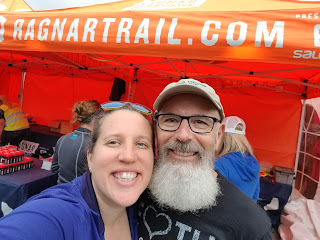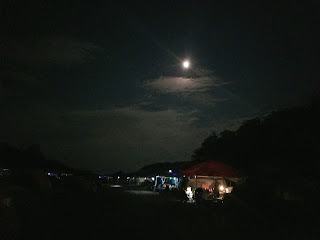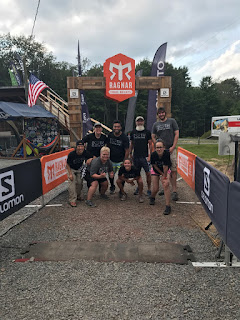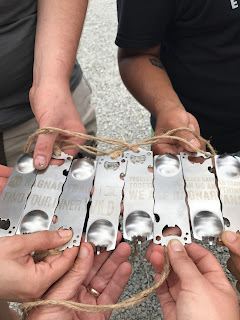RAGNAR TRAIL RELAY - WEST VIRGINIA
After
a quick trip to Big Bear Lake in the local mountains of Southern California in
early July, it was off to another Big Bear Lake in August. Tucked away in the
upper northeast corner of West Virginia, just south of the Pennsylvania border
and just west of the Maryland border, is Big Bear Lake Camplands, Bruceton
Mills, WV. It is a sprawling private campground, and the site of this year’s
Ragnar Trail Relay – Appalachians WV.
According
to the Ragnar website, Ragnar was a wild and crazy Scandinavian king from the 9th
century. The Ragnar organization expects its participants to tap into this
legacy through its overnight trail run/camping/celebratory race events. This
was my first involvement with an overnight team relay run, and I was looking
forward to finding out what it was going to be like.
Since
this is a team event, the first thing you have to do is get together a team. We
were in the open mixed division, which required 8 team members and a volunteer
(volunteers do not run – they are required to work a shift as part of the
Ragnar race support staff). Stephanie and Stephen had just run the Richmond (VA)
Ragnar in April, so they had some experience in this regard. They also had a
few potential team members lined up.
However,
lining up a team is kind of like herding cats. There are those who are truly committed
from the start, those who are initially excited at the idea (but balk at the
reality), and those who won’t sign on until the very end. And, there are those
who fully intend to participate but, for various legitimate reasons, have to
back out. Luckily for me, it was Stephanie and Stephen who dealt with the
logistics of getting the team together, using their contacts in the northern
Virginia area. We started the process in June and by early August we had 8
runners and 1 volunteer ready to go.
Here’s a brief overview of how the team trail
run works: The race begins Friday morning and it ends late the following
Saturday afternoon. The course consists of three separate trail loops, which
are graded ‘green’ (easiest), ‘yellow’ (moderate), and ‘red’ (difficult). Each
of the 8 runners on the team must run each of the 3 separate trail loops during
that time period. This means there are 24 loops (each of the 8 runners
completing 3 loops) per team and your team always has a runner out on the
course. It also means that runners will run at least one, if not more, loops in
the dark.
|
RUNNER
|
LOOP
|
|
1
– Steve
|
Green
|
|
2
– Stephen
|
Yellow
|
|
3
– Stephanie
|
Red
|
|
4
– Danielle
|
Green
|
|
5
– Kyleen
|
Yellow
|
|
6
– ‘ghost’ (Steve)
|
Red
|
|
7
– Luan
|
Green
|
|
8
– Deb
|
Yellow
|
|
1
|
Red
|
|
2
|
Green
|
|
3
|
Yellow
|
|
4
|
Red
|
|
5
|
Green
|
|
6
- (Danielle)
|
Yellow
|
|
7
|
Red
|
|
8
|
Green
|
|
1
|
Yellow
|
|
2
|
Red
|
|
3
|
Green
|
|
4
|
Yellow
|
|
5
|
Red
|
|
6
– (Jake)
|
Green
|
|
7
|
Yellow
|
|
8
|
Red
|
At
our race, the green loop was 3.5 miles in distance with an elevation gain/loss
of 427 feet, the yellow loop 4.6 miles with 579 ft. gain/loss, and red at 6.5
miles with 1050 ft. gain/loss (note: the scuttlebutt around camp was that the
red loop was miscalculated for the first half of the race – it was really 7.5
miles – until it was corrected sometime late Friday night/early Saturday
morning).
At
a Ragnar Trail race, you camp out. Leading up to the start of the race, a small
city of tents and canopies sprouts up as each team sets up their respective
campsite. I’m guessing we had between 2500 to 3000 campers in the area. Each
campsite is immediately adjacent to the next, so this provides ample
opportunity to get to know the campers on either side of you. You bring your
tent to a Ragnar race as a place to store your gear and to change your clothes –
there is very little sleep involved.
Stephanie and Stephen brought their EZ-up
canopy with them and this served as the team gathering spot – where we sat
around telling stories about our latest loop, sheltered ourselves from the occasional
rain shower, and munched on snacks. All of our team tents were set up behind
the canopy.
We
were camped about a quarter mile from the Ragnar Village, which was made up of
the transition area (where all the trail loops began and ended and where
runners ending their loops transferred their timing belts to the team mate
beginning the next loop), the dining tent, the food vendors, the running
equipment vendors, the medical tent, portable toilets, the fire ring, the phone
charging station, the filtered water station, and the outdoor movie theater.
During the course of the weekend, we made countless trips back and forth between
our campsite and the village.
Our
team’s starting time was scheduled for 11:30am Friday morning. We managed to
get our gear unloaded and our tents set up about 90 minutes before the start. I
was assigned to be runner number 1, Stephen was number 2 and Stephanie was
number 3. This meant I’d start with the green loop, then Stephen would run the
yellow loop and Stephanie would run the red loop. There is a certain
psychological comfort in running the red loop as your first loop, since the
hardest loop comes when you’re at your most rested. For those starting on green
or yellow, you get that edge of anticipation as you wait for the more difficult
loops to come.
Shortly
before we traveled to the race, we learned that one of our team mates would
not be able to run. We had also picked up a team member just days before the start
of the race when Kyleen (who is a friend of a friend of someone on the team)
agreed to fill in for us. This left us with 7 runners and 1 volunteer. In order
to complete all 24 loops, some of us would have to run more than our 3 loops.
We decided to make runner number 6 be our ‘ghost’ runner and this slot is where
the extra loops would get run. I volunteered to run the first ‘ghost’ slot,
which turned out to be a red loop.
My own red loop slot would come up two
runners after that. The good news was that I’d get a preview of the most
difficult loop while it was still light outside. The other side of that was I’d
only have about 2 hours to rest before doing the red loop again, this time in
the dark. Our number 4 runner, Danielle, volunteered to run the second ‘ghost’
slot, which was the yellow loop. She would have an even shorter time between
loops, with only one runner between her slots – each of these loops would also
be in the middle of the night. We left the question of who would run the final ‘ghost’
loop (which would be green) until later.
At
11:30am on Friday, I took off on the green loop. Because several other teams
were starting their first loop at the same time, there was quite a crowd on the
trail for the first mile or so. At approximately 2500 feet of elevation, the
temperature was a little cooler than down in the flatlands. The weather
forecast called for scattered thundershowers with temperatures in the high 70’s.
This was very pleasant for the east coast crowd, but I found it to be quite
humid, especially compared to what we usually have in Southern California. It
didn’t take long to become completely soaked in sweat.
The
green loop trail was described as the easiest trail and I suppose that was
because the distance and elevation change was lower than the other loops.
However the single track portions of the trail were quite rocky and wet,
particularly in places where we ran along or within stream/drainage beds. The
trail was largely within the forest canopy, which magnified the effects of the
humidity. I was taken with how green everything is in this part of the country,
and the green loop was definitely green.
I found this to be a relatively
difficult loop due to the slippery and jagged trail surface. In fact, I took a
spill at about mile 2 when I took my eyes off the trail for a moment. Like any
proud (and, embarrassed) runner, I quickly bounced up, dusted off, looked
around to see if anyone saw the fall, and continued along no worse for the
wear. All three loops converged at about a half mile out from the finish line
(site of the transition station) and at about a quarter mile from the finish
there was a timing mat.
As soon as you crossed the timing mat, your team number
flashed up on computer display screens set up in the village area. This was the
cue for the next runner on your team to get to the transition area to start the
next loop. The last quarter mile ran through a section of runner’s campsites,
so there was always an enthusiastic cheering section (night and day) when you
came to the end. As runners finished our loops, we ran up a ramp onto a
pedestrian overpass, and down into the transition area. This is where we would
come to cheer on our team mates. I finished my first loop, Stephen took off on
his, and I went back to camp for some water and lunch.
It
was just before 6:00pm when my next loop came up (the first of my two reds) and
it was plenty warm and humid for this California boy. The red loop was a narrow
single track trail for the most part. The trail surface was a mix of uneven
moss-covered rocks and numerous tree roots alternating with jagged rocks. Most
of the elevation loss was in the first 2 miles and the bulk of the elevation
gain was in the last 4.5 miles. There were several little downhill sections
where you really had to be careful with your footing. The forest was beautiful,
but you didn’t have much time for sight-seeing on these gnarly trails.
Scattered light rain and lots of colorful mushrooms on the forest floor
reminded me of the humidity as I ran up and down the hills.
I found the footing
on the red loop to be easier than on the green loop. I was making pretty good
time until about mile 5.5, when I again took a dive. This time, it was in a
section of the trail that was covered in a soft loamy surface (although with
rocks just below the surface) so that it was like falling into a gentle pile of
fertilizer. Although no one else saw me fall, I could not rid myself of the
evidence since my sweaty body was covered with debris from the trail. This
preview of the red loop was very useful to me, knowing that I’d be running it
again within the next two hours in the darkness. I also vowed to pay closer
attention to where my feet were going when I ran my next two loops. I finished
my first red at around 7:15pm.
After
a quick light meal and rehydration, it was already nearly time for my next red
loop. At about 9:00pm I lined up to start my first night time run. Although I’d
just run the loop a couple of hours earlier, I was still entering uncharted
territory: I don’t usually run trails at
night, and I don’t usually run multiple segments so close together. I felt
pretty rested, even though I’d been on my feet almost the entire day, between
running and cheering on our team mates.
I
used a headlamp and a hand-held flashlight and I’m glad I did. The combination
of lights really helped show the contours of the trail surface. Lots of runners
had very elaborate LED vests, tail lights, headlamps and other reflective gear.
When I came upon them in the dark it was quite striking. There were sections of
the trail where you could look up ahead and see several tiny lights blinking in
among the trees as runners went up and over hills and ridges. The red loop was
wetter and more slippery the second time around, and I took it much more slowly
on the downhill sections. This, combined with darkness and a little bit of
trail fatigue, added about 15 minutes to my overall time. By the time I rolled
into the transition area, it was getting close to 10:30pm and I was looking
forward to dinner and some rest.
Ragnar
provided dinner for us Friday night and Stephanie picked up the grilled
chicken, green bean, mac & cheese, cornbread feast and left it in a cooler
for me at the campsite. By the time I cooled down and dried off (you never
really dry off completely in the humidity), I sat down at about 11:00pm to a
nice cold dinner in the dark – it tasted great! Most of our team was either
trying to get some sleep in their tents, or waiting to start their next loop, so
the campsite was pretty quiet – although there was always a general buzz of activity
all through the night throughout the tent areas with runners constantly
arriving and/or departing. I switched into some dry clothes and climbed into my
tent to see if I could sleep for awhile.
The
first thing I noticed when I bent down to get into the tent was that my calves
wanted to seize up on me. Even though I’d stayed pretty well hydrated
throughout the day, my muscles were feeling the effects of so many trail miles
in such a short span of time. This made the task of removing my shoes and socks
a lot more difficult than it should have been. The next thing I noticed was
that once I cooled down, it was starting to feel downright cold as my
metabolism began to slow into rest mode. I was glad Stephanie let me use her
sleeping bag. Under other circumstances, it would have been too warm to use a
bag in those temperatures. After about an hour, I could move around without my
legs feeling like they would spasm. I never did get to sleep, but I managed to
get plenty of rest.
During
our stay, the annual Perseid Meteor Showers were taking place. Stephanie and
Stephen reported that they’d seen several meteors while waiting for their night
time running slots. Sadly, the only flashing lights I saw were when I stood up
too quickly from tying my shoes.
The
night time strategy for the team was to have an incoming runner wake you up in
time for your next run. This usually meant the runner who woke you was the one
who was two slots ahead of you. Our plan was to have Luan wake me when she came
back from her red loop at about 5:00am. I woke up at about 4:30am on my own and
got into my running gear for my final loop. When I climbed out of the tent,
there was no one awake in our campsite. I wasn’t sure who was out on the trail,
so I walked into the village to see if any of our team was there. I didn’t see
anyone, so I decided to use the charging station to get my phone up to speed
again. I sat around the fire ring for about an hour, periodically checking the
computer displays to see if our runner was coming in.
When I went back to the
camp just before 6:00am, one of our camping neighbors told me that Stephanie
had asked Luan (who had somehow returned to camp without me seeing her) if she’d
awakened me. When Luan remembered she had not done so, she and Stephanie stood
outside my tent calling for me to wake up. When I did not answer, they went
into the tent and discovered me gone! Since it was dark and no one had seen me,
there was some concern about what had happened (an alien abduction could not be
completely ruled out) and about whether we’d have someone ready to run the next
leg.
After a good laugh,
I made my way back to the village and ran into Deb, who had just finished her
green loop. I ran to the transition area, put on the timing belt and headed out
for the yellow loop. The sun was just below the horizon when I started, so I
did not need a headlamp. The yellow loop was probably the most scenic loop. The
trail surface was really quite smooth and this made the elevation changes much
easier to handle, especially the downhill sections. The morning light coming
through the trees, the fern meadows, and the morning mist made this a nice loop
to finish up on. If this had been my first loop, it could have easily been my
fastest loop. As it turned out, there was not the same spring in my step on
this loop. It was also surprising to me how humid it could be at this time of
the morning. Nevertheless, I sailed through the yellow loop and gladly handed
the timing belt to Stephen in the transition area.
Back
at the campsite, it was time for some rehydration and some food. One of our
camping neighbors was trying to get rid of extra hamburgers and beer and a
couple of us gladly agreed to help him out. After Stephen and Stephanie
finished their last loops, we did some camp clean up while our last runners
were out on the course. In the meantime, our volunteer, Jake, agreed to run the
third ‘ghost’ loop (green). This really helped out the team since by that time there
was not a lot of enthusiasm from the rest of the team for running an extra
loop.
For
those of us who had finished all our loops, we spent the remainder of the late morning and
afternoon eating, drinking, talking, and even a little bit of ukulele playing,
until it got close to the time for our final runner to complete her loop.
When
Deb crossed the quarter mile timing mat, our whole team gathered along the
trail near the pedestrian overpass and finished as a group with her as she
entered the transition area 29 hours and 41 minutes after we began our first
loop. We posed for some team photos, picked up our finisher medals, swapped a
few stories about our loops and jumped into our cars to head home.
I’ll
rate this experience a 10 out of 10. Although some of our team members knew
each other before the race, others of us were meeting each other for the first
time. Through the shared experience of the camping and the running we built up
good camaraderie within a very brief span of time. Yes, I’d do it again!
POST-RAGNAR
BICYCLE TOUR OF THE NATIONAL MALL and TRAVELS WITH EOTH
When
we got back from the Ragnar on Saturday night, Alison and Andrew met us in
Herndon with a delicious take-out Italian meal. After eating, Stephanie handed
me off to Alison and Andrew and we drove back to their house for a quick visit.
The next morning while Andrew golfed, Alison and I jumped on the bicycles and
rode over to the National Mall for some sight-seeing. The Arlington/D.C. area
is a pretty bicycle-friendly area and it’s relatively easy to avoid motor
vehicle traffic. We hit the cafeteria at the Native American museum for a great
lunch and then headed over to the National Art Gallery rooftop for a view of
the surrounding area. We had a great ride up the bicycle lane that runs up the
center of Pennsylvania Avenue, which has a nice view of the Capitol Dome as you
head up the street. After a nice climb up the hills near the Netherlands Carillon,
we were ready for a cool beer.
Later that night, I got to join Alison, Andrew
and several of their friends for a barbeque, some ukulele playing and a viewing
of the latest Game of Thrones episode. The next morning, Andrew dropped me off
at the Metro station and I took the silver line out to Reston, where Stephanie
and Stephen picked me up.
I
got to tag along with them as they went through a typical work day on their
non-profit, EOTH (Eye Of The Heart). This included visiting a metal reclaiming
site, a personal organizing client and dog-sitting.
The
next day, we visited the Steven F. Udvar-Hazy National Air and Space Museum
(Smithsonian) in Fairfax County. Stephen had arranged for one of his
clients/friends to meet us there for a guided tour. Richard and Kathy are the
friends, and Richard worked in security at the museum from 2003 until his
recent retirement. We spent a few hours touring the museum and had a great
time.
Next
trip: 40th Wedding
Anniversary Trip to San Francisco















